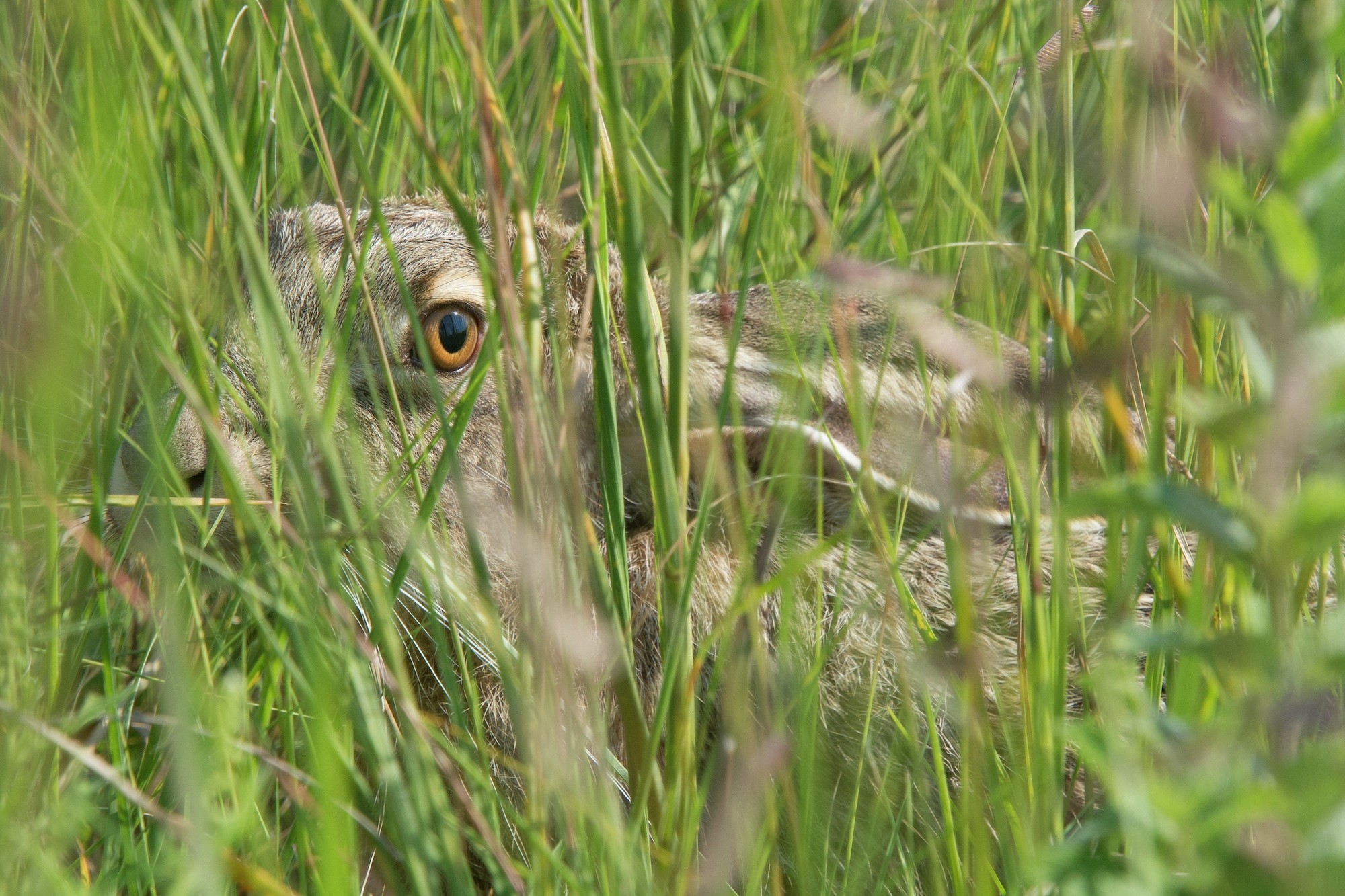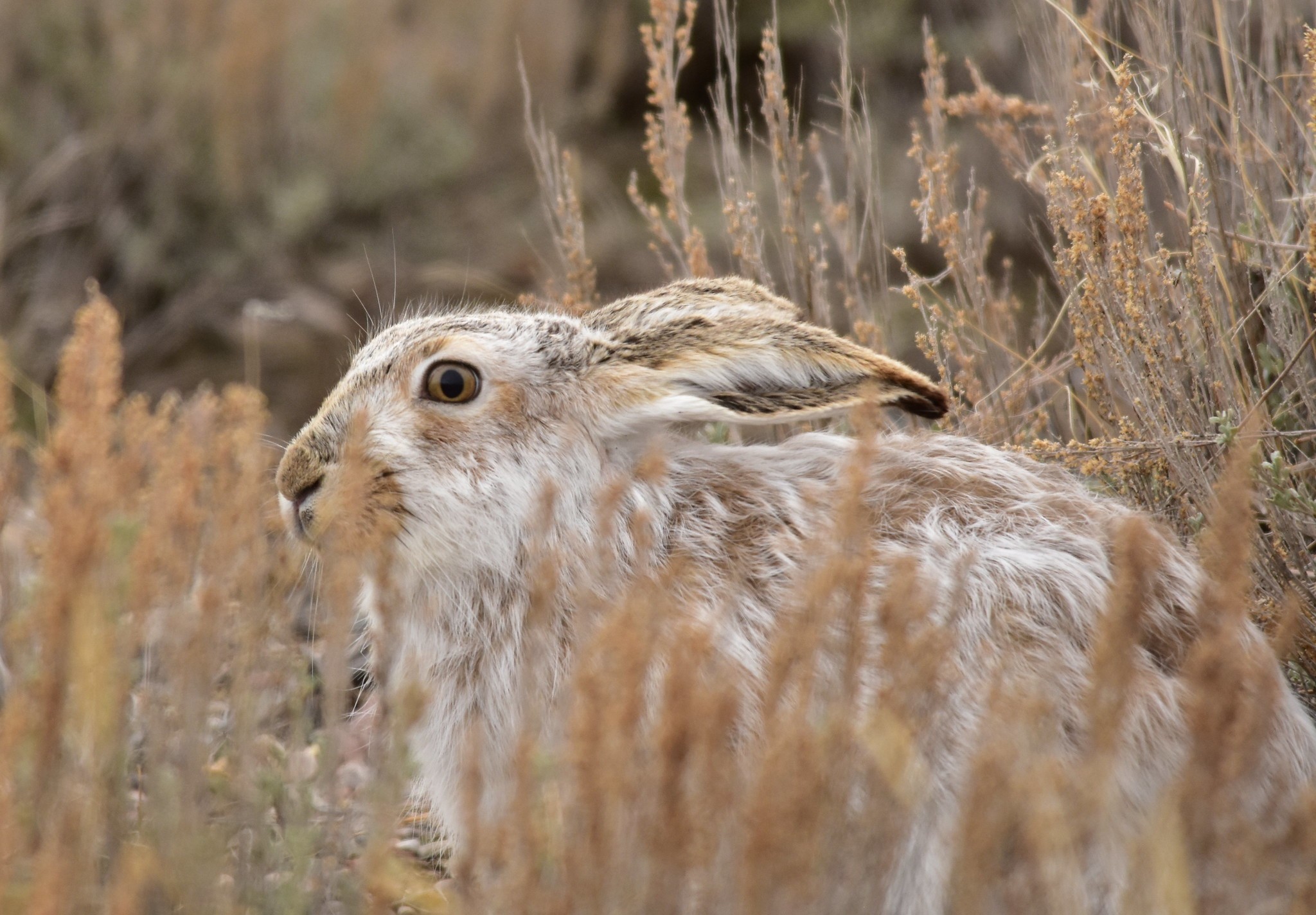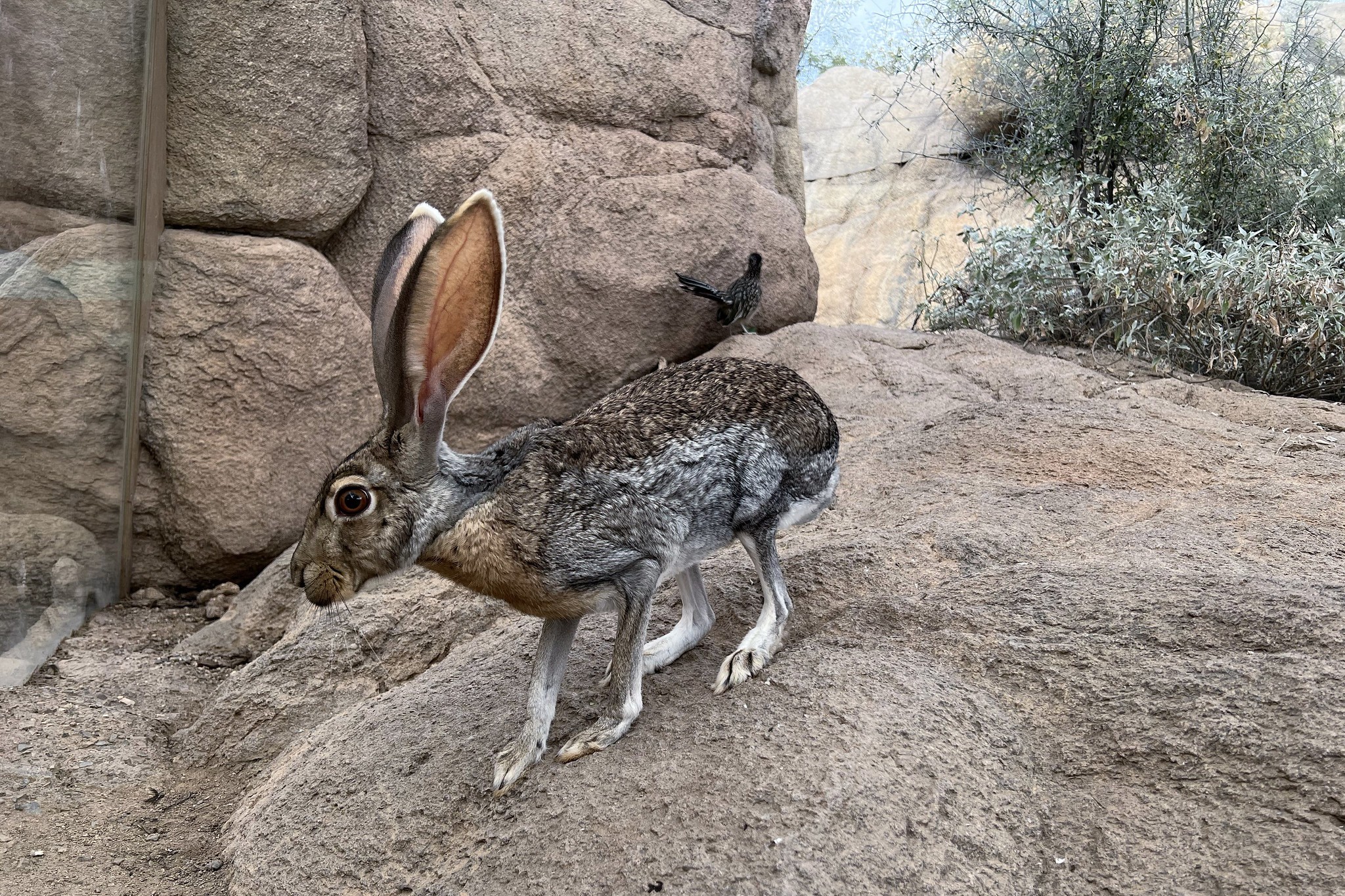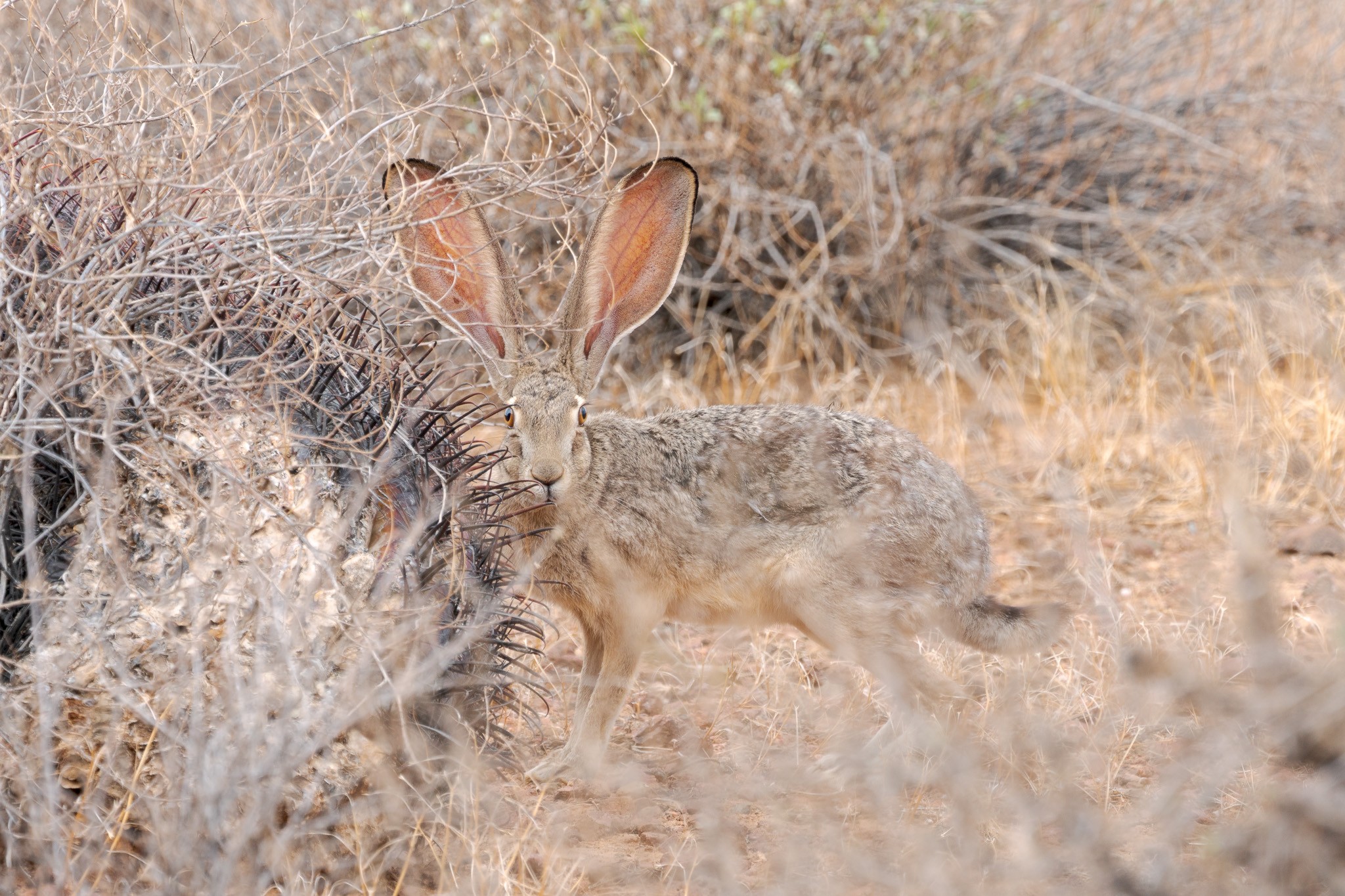Are Jackrabbits Good Pets? Not typically, due to their wild nature and specific needs that are difficult to meet in a domestic setting. PETS.EDU.VN aims to provide comprehensive information on whether these wild animals can truly thrive as pets and what to consider. Discover the wild side of jackrabbits, understanding their habitat, care requirements, and potential health issues, and learn how to best support their well-being, exploring the legality of keeping them as pets, dietary needs, and whether rewilding is an option.
1. What is a Jackrabbit?
Jackrabbits, often mistaken for rabbits, are actually hares belonging to the Lepus genus. These fascinating creatures are native to North America and are known for their long ears and powerful legs, perfectly adapted for survival in the wild. Understanding their biology and behavior is crucial before considering them as pets.
1.1 Key Characteristics of Jackrabbits
Jackrabbits have several distinctive features:
- Size and Weight: They can weigh between 5 to 9 pounds and measure up to two feet long.
- Ears: Their large ears, crucial for hearing and thermoregulation, are a defining characteristic.
- Legs: Powerful hind legs enable them to leap up to 20 feet and run at speeds of 30 miles per hour.
1.2 Jackrabbit vs. Rabbit
It’s essential to differentiate jackrabbits from rabbits. Hares, like jackrabbits, are typically larger, and their young are born fully furred and capable of moving around shortly after birth. Rabbits, on the other hand, are born hairless and dependent.
| Feature | Jackrabbit (Hare) | Rabbit |
|---|---|---|
| Size | Larger (5-9 pounds) | Smaller |
| Young | Born furred and mobile | Born hairless and helpless |
| Habitat | Open country, deserts, grasslands | Burrows and underground dens |
| Social Behavior | More solitary | More social, often living in groups |




1.3 Habitat and Behavior
Jackrabbits inhabit open areas such as sagebrush flats, deserts, and grasslands. They require ample space to run and hide. Their wild nature makes them wary and active mainly at dawn and dusk.
2. The Legalities of Keeping Jackrabbits as Pets
Before considering a jackrabbit as a pet, it’s essential to understand the legal implications. Regulations vary widely depending on your location.
2.1 State and Local Laws
Many states and local jurisdictions have strict laws regarding the possession of wild animals. It is often illegal to capture and keep jackrabbits without proper permits. For instance, some states may require specific licenses for wildlife rehabilitation, which do not automatically permit keeping the animal permanently.
2.2 Permits and Licenses
If keeping a jackrabbit is legal in your area, you may need to obtain permits or licenses from your local wildlife agency. These permits often come with specific requirements regarding housing, care, and eventual release or transfer of the animal.
2.3 Ethical Considerations
Even if it is legal to keep a jackrabbit, consider the ethical implications. Wild animals have evolved to thrive in their natural habitats, and confining them to a domestic setting can cause stress and behavioral issues.
3. Understanding the Unique Needs of Jackrabbits
Jackrabbits have specific needs that are difficult to replicate in a domestic environment. These animals are adapted to a wild existence, and their requirements reflect this.
3.1 Habitat Requirements
Jackrabbits need a large, secure outdoor enclosure. A spacious area allows them to exhibit natural behaviors such as running, jumping, and foraging. The enclosure should be predator-proof to protect them from domestic animals and other wildlife.
- Space: Minimum 100 square feet of enclosure space per jackrabbit.
- Fencing: Secure fencing at least 4 feet high to prevent escapes.
- Shelter: Provide natural shelters such as shrubs, logs, and artificial hides.
3.2 Dietary Needs
Jackrabbits are herbivores and require a diet rich in fiber. Their diet should consist primarily of grasses, hay, and leafy greens. Commercial rabbit pellets can supplement their diet, but should not be the primary food source.
- Grasses and Hay: Timothy hay, orchard grass, and other natural grasses should make up the bulk of their diet.
- Leafy Greens: Offer a variety of leafy greens such as romaine lettuce, kale, and parsley.
- Avoid: Sugary fruits and vegetables, as these can cause digestive issues.
3.3 Social and Behavioral Needs
Jackrabbits are generally solitary animals, especially in adulthood. They are most active at dawn and dusk and spend much of the day resting in secluded spots. Understanding their social behavior is crucial to avoid stressing the animal.
- Solitary Nature: Jackrabbits typically prefer to live alone, especially as adults.
- Activity Patterns: They are most active during dawn and dusk, requiring a quiet, secure space during the day.
- Enrichment: Provide environmental enrichment such as branches, tunnels, and digging opportunities to stimulate natural behaviors.
4. The Challenges of Taming a Wild Jackrabbit
Taming a wild jackrabbit is extremely difficult and often unsuccessful. Their natural wariness and fear of humans make them resistant to domestication.
4.1 Natural Wariness
Jackrabbits are prey animals with a strong instinct to flee from danger. This makes it challenging to establish trust and build a bond.
4.2 Stress and Anxiety
Confinement and human interaction can cause significant stress and anxiety in jackrabbits. Signs of stress include:
- Excessive Grooming: Over-grooming can lead to hair loss and skin irritation.
- Hiding: Spending excessive time hiding and avoiding interaction.
- Aggression: Biting or scratching when approached.
4.3 Limited Interaction
Even with dedicated effort, jackrabbits rarely become affectionate pets. They may tolerate human presence, but are unlikely to seek out physical contact or interaction.
5. Potential Health Issues
Jackrabbits are susceptible to various health issues, many of which are exacerbated by the stress of captivity.
5.1 Common Diseases
- Parasites: Including fleas, ticks, and mites.
- Respiratory Infections: Pneumonia and other respiratory issues are common in stressed animals.
- Dental Problems: Overgrown teeth can cause pain and difficulty eating.
- Gastrointestinal Issues: Diarrhea and bloating due to improper diet or stress.
5.2 Veterinary Care
Finding a veterinarian experienced in treating jackrabbits can be challenging. Many vets lack the expertise to properly diagnose and treat these animals.
5.3 Preventative Care
Regular check-ups, proper diet, and a stress-free environment are crucial for preventing health issues. Consult with a knowledgeable veterinarian to develop a preventative care plan.
6. Dietary Guidelines for Jackrabbits
Providing the right diet is essential for maintaining the health and well-being of jackrabbits. Their digestive systems are adapted for high-fiber foods, and improper diet can lead to serious health problems.
6.1 Essential Nutrients
- Fiber: Crucial for digestive health, should make up the majority of their diet.
- Vitamins and Minerals: Leafy greens and a small amount of commercial pellets can provide essential vitamins and minerals.
- Water: Fresh, clean water should always be available.
6.2 Food to Avoid
- High-Sugar Foods: Fruits and sugary vegetables can cause digestive upset.
- Grains: Avoid grains as they are not a natural part of their diet.
- Processed Foods: Human snacks and processed foods are harmful.
6.3 Sample Diet Plan
| Food Type | Percentage of Diet | Example |
|---|---|---|
| Grasses/Hay | 80% | Timothy hay, orchard grass |
| Leafy Greens | 15% | Romaine, kale, parsley |
| Rabbit Pellets | 5% | High-fiber, low-protein |
7. Creating a Suitable Habitat
A suitable habitat for a jackrabbit should mimic their natural environment as closely as possible. This includes providing ample space, shelter, and enrichment.
7.1 Enclosure Size and Design
- Large Space: A minimum of 100 square feet per jackrabbit is recommended.
- Secure Fencing: Fencing should be at least 4 feet high and buried to prevent digging.
- Predator Protection: Cover the top of the enclosure with netting to protect from birds of prey and other predators.
7.2 Environmental Enrichment
- Natural Substrates: Use natural substrates such as soil, grass, and sand.
- Hiding Spots: Provide multiple hiding spots such as shrubs, logs, and artificial hides.
- Digging Opportunities: Allow opportunities for digging by providing loose soil or sand.
7.3 Temperature Control
Jackrabbits are adapted to a wide range of temperatures but should be protected from extreme heat and cold.
- Shade: Provide shade during hot weather to prevent overheating.
- Insulation: Insulate shelters during cold weather to provide warmth.
8. Ethical Considerations of Keeping Wild Animals
Keeping wild animals like jackrabbits as pets raises significant ethical concerns. It’s essential to consider the animal’s welfare and the impact on wild populations.
8.1 Animal Welfare
Wild animals have evolved to thrive in their natural habitats. Confining them to a domestic setting can cause stress, behavioral issues, and health problems.
8.2 Conservation Concerns
Removing jackrabbits from their natural habitat can negatively impact wild populations. This is especially concerning for species with small or declining populations.
8.3 Alternatives
Consider supporting wildlife conservation efforts or volunteering at a wildlife rehabilitation center as an alternative to keeping a wild animal as a pet.
9. The Reality of Rewilding Jackrabbits
Rewilding a jackrabbit that has been kept in captivity is extremely challenging and often unsuccessful. These animals lose their natural survival skills and may not be able to adapt back to the wild.
9.1 Loss of Survival Skills
Captive jackrabbits may lose their ability to forage, find shelter, and avoid predators.
9.2 Social Integration
Reintroducing a captive jackrabbit into a wild population can disrupt social dynamics and introduce diseases.
9.3 Legal Restrictions
Releasing a captive wild animal into the wild may be illegal in your area.
10. Jackrabbit Species and Their Specific Needs
There are several species of jackrabbits, each with specific needs and conservation status. Understanding these differences is crucial for responsible wildlife management.
10.1 Black-Tailed Jackrabbit
The black-tailed jackrabbit (Lepus californicus) is the most common species, found throughout the western United States and Mexico. They are adaptable but still require ample space and a high-fiber diet.
- Habitat: Open and semi-open habitats, sagebrush country.
- Diet: Grasses, forbs, and shrubs.
- Conservation Status: Generally abundant, but populations can fluctuate.
10.2 White-Tailed Jackrabbit
The white-tailed jackrabbit (Lepus townsendii) is found in the northern parts of the western United States and upper Midwest. They turn white in winter, requiring specific adaptations for cold climates.
- Habitat: Northern grasslands and open areas.
- Diet: Grasses, forbs, and bark in winter.
- Conservation Status: Declines have been reported in many areas.
10.3 Antelope Jackrabbit
The antelope jackrabbit (Lepus alleni) is found in southern Arizona and northern Mexico. They have large ears and long legs, adapted for desert environments.
- Habitat: Desert grasslands and scrublands.
- Diet: Cacti and other desert vegetation.
- Conservation Status: Locally common.
10.4 Other Species
Other jackrabbit species, such as the white-sided jackrabbit, Tehuantepec jackrabbit, and black jackrabbit, have limited ranges and specific conservation concerns.
11. Sourcing Jackrabbits: Why You Shouldn’t
It is generally not advisable to source jackrabbits for the purpose of keeping them as pets due to ethical, legal, and practical reasons.
11.1 Ethical Concerns
Removing a jackrabbit from its natural habitat disrupts the ecosystem and can cause stress and suffering for the animal.
11.2 Legal Issues
Many jurisdictions have laws protecting native wildlife, making it illegal to capture and keep jackrabbits without proper permits.
11.3 Practical Challenges
Jackrabbits have specific needs that are difficult to meet in captivity, making them unsuitable as pets.
12. Alternatives to Keeping Jackrabbits as Pets
If you’re an animal lover but recognize the challenges of keeping a jackrabbit as a pet, consider these alternatives.
12.1 Domestic Rabbits
Domestic rabbits are bred to be pets and are well-suited to living in a domestic environment. They come in a variety of breeds, each with unique characteristics.
- Breeds: Dutch, Mini Rex, Lop, and more.
- Temperament: Bred for companionship and can be affectionate.
- Care: Easier to care for than wild jackrabbits.
12.2 Wildlife Rehabilitation
Volunteer at a wildlife rehabilitation center to help care for injured or orphaned jackrabbits. This allows you to contribute to their well-being without keeping them permanently.
- Hands-On Experience: Learn about jackrabbit care from experienced professionals.
- Contribution: Help rehabilitate and release jackrabbits back into the wild.
12.3 Conservation Efforts
Support organizations that work to protect jackrabbit habitats and conserve wild populations.
- Donations: Contribute financially to conservation efforts.
- Advocacy: Advocate for policies that protect jackrabbits and their habitats.
13. The Role of Wildlife Rehabilitation Centers
Wildlife rehabilitation centers play a crucial role in caring for injured or orphaned jackrabbits and other wildlife.
13.1 Rescue and Care
These centers rescue jackrabbits that have been injured or orphaned and provide medical care, food, and shelter.
13.2 Rehabilitation
Rehabilitation involves helping the animals recover from their injuries and develop the skills they need to survive in the wild.
13.3 Release
Once the animals are healthy and self-sufficient, they are released back into their natural habitat.
14. Conservation Status of Jackrabbits
The conservation status of jackrabbits varies depending on the species and their geographic location.
14.1 Threats to Jackrabbits
- Habitat Loss: Conversion of grasslands and deserts to agriculture and urban development.
- Predation: Increased predation due to habitat fragmentation.
- Climate Change: Changes in temperature and precipitation patterns.
14.2 Conservation Efforts
- Habitat Restoration: Restoring degraded habitats to provide suitable habitat for jackrabbits.
- Predator Control: Managing predator populations to reduce predation pressure.
- Climate Change Mitigation: Reducing greenhouse gas emissions to mitigate the impacts of climate change.
15. Jackrabbits in Popular Culture
Jackrabbits have a prominent place in popular culture, often depicted as symbols of the American West.
15.1 Symbolism
They are often seen as symbols of resilience, adaptability, and independence.
15.2 Media Representation
Jackrabbits appear in cartoons, books, and movies, often portrayed as fast and elusive creatures.
15.3 Tourism Kitsch
They are a common motif in tourist souvenirs and kitsch, representing the unique charm of the American West.
16. How to Observe Jackrabbits in the Wild
Observing jackrabbits in their natural habitat can be a rewarding experience. Here are some tips for spotting these elusive creatures.
16.1 Best Times
The best times to see jackrabbits are at dawn and dusk when they are most active.
16.2 Locations
Look for them in open areas such as grasslands, deserts, and sagebrush flats.
16.3 Techniques
- Drive Slowly: Cruise slowly along quiet roads, scanning the sides for animals.
- Walk Slowly: If walking, move slowly and quietly, scanning the brush ahead.
- Use Binoculars: Binoculars can help you spot jackrabbits from a distance.
17. Dispelling Myths About Jackrabbits
There are many misconceptions about jackrabbits. Let’s dispel some of the common myths.
17.1 Myth: Jackrabbits are Rabbits
Fact: Jackrabbits are hares, not rabbits. They have different physical characteristics and behaviors.
17.2 Myth: Jackrabbits Make Good Pets
Fact: Jackrabbits are wild animals with specific needs that are difficult to meet in captivity.
17.3 Myth: Jackrabbits are Easy to Tame
Fact: Jackrabbits are naturally wary and difficult to tame.
18. The Importance of Responsible Pet Ownership
Responsible pet ownership involves understanding the needs of your pet and providing them with the best possible care.
18.1 Research
Before getting a pet, research their specific needs and requirements.
18.2 Commitment
Be prepared to commit to the long-term care of your pet.
18.3 Resources
Ensure you have the resources to provide your pet with proper food, shelter, and medical care.
19. Community Engagement and Education
Engaging with your community and educating others about jackrabbits and wildlife conservation can make a positive impact.
19.1 Local Groups
Join local wildlife conservation groups and participate in educational events.
19.2 Social Media
Share information about jackrabbits and wildlife conservation on social media.
19.3 Educational Programs
Support educational programs that teach children about wildlife and conservation.
20. Jackrabbit Conservation Success Stories
Despite the challenges, there have been some successes in jackrabbit conservation.
20.1 Habitat Restoration Projects
Habitat restoration projects have helped to improve jackrabbit habitats and increase their populations.
20.2 Protected Areas
The establishment of protected areas has helped to safeguard jackrabbit habitats from development and other threats.
20.3 Community Involvement
Community involvement in conservation efforts has helped to raise awareness and support for jackrabbit conservation.
21. The Future of Jackrabbits
The future of jackrabbits depends on our ability to protect their habitats and mitigate the threats they face.
21.1 Continued Research
Continued research is needed to better understand jackrabbit ecology and behavior.
21.2 Conservation Policies
Strong conservation policies are needed to protect jackrabbit habitats and regulate human activities that may harm them.
21.3 Public Awareness
Increased public awareness and support for jackrabbit conservation are essential for ensuring their survival.
22. Debunking Common Jackrabbit Myths
Let’s address some frequent misconceptions about jackrabbits to provide a clearer understanding.
22.1 Jackrabbits Are Low-Maintenance
Reality: Jackrabbits require specific, demanding care routines, including a large enclosure, specialized diet, and constant monitoring for signs of stress or illness. Their care needs are far from low-maintenance.
22.2 They Thrive in Small Spaces
Reality: Jackrabbits need plenty of space to exhibit natural behaviors like running and jumping. Confining them to small spaces can lead to stress and health problems.
22.3 Jackrabbits Are Affectionate Pets
Reality: Jackrabbits are wild animals with an inherent fear of humans. They rarely form strong bonds and may never become truly affectionate.
23. Jackrabbit Behavior and Psychology
Understanding jackrabbit behavior and psychology is crucial to appreciating why they are not suitable as pets.
23.1 Instinctive Behaviors
- Flight Response: Jackrabbits are prey animals with a strong instinct to flee from danger.
- Foraging: They spend a significant amount of time foraging for food.
- Solitary Nature: They are generally solitary animals, preferring to live alone.
23.2 Stress Indicators
- Hiding: Spending excessive time hiding.
- Aggression: Biting or scratching.
- Self-Mutilation: Over-grooming or plucking fur.
23.3 Meeting Psychological Needs
Meeting the psychological needs of a jackrabbit in captivity is challenging due to their wild nature and inherent fear of humans.
24. Jackrabbit Housing: Creating a Natural Environment
If, against all recommendations, you still consider housing a jackrabbit, creating an environment that closely mimics their natural habitat is critical.
24.1 Outdoor Enclosure
- Size: Minimum of 100 square feet per jackrabbit.
- Security: Predator-proof fencing and a covered top.
- Substrate: Natural soil, grass, and sand.
24.2 Shelter and Hiding Spots
- Shrubs: Plant native shrubs for cover.
- Logs: Provide logs for hiding and climbing.
- Artificial Hides: Use artificial hides to create secure spaces.
24.3 Environmental Enrichment
- Digging Area: Create a digging area with loose soil or sand.
- Branches: Provide branches for chewing and climbing.
- Toys: Use safe, non-toxic toys to stimulate play.
25. Detailed Jackrabbit Dietary Needs
A jackrabbit’s diet is essential for maintaining their health. A proper diet mimics what they would eat in the wild.
25.1 Grasses and Hay
- Types: Timothy hay, orchard grass, and other natural grasses.
- Availability: Should be available at all times.
- Benefits: Provides essential fiber for digestive health.
25.2 Leafy Greens
- Variety: Romaine lettuce, kale, parsley, and cilantro.
- Quantity: Offer a variety of leafy greens daily.
- Benefits: Provides essential vitamins and minerals.
25.3 Limited Pellets
- Type: High-fiber, low-protein rabbit pellets.
- Quantity: Offer a small amount of pellets as a supplement.
- Benefits: Provides additional nutrients but should not be the primary food source.
25.4 Water
- Availability: Fresh, clean water should always be available.
- Containers: Use a water bottle or a heavy ceramic bowl.
- Hygiene: Clean water containers daily to prevent bacterial growth.
26. Health Risks in Captive Jackrabbits
Captivity poses several health risks for jackrabbits.
26.1 Stress-Related Illnesses
- Weakened Immune System: Stress can weaken the immune system, making them more susceptible to infections.
- Gastrointestinal Issues: Stress can disrupt their digestive system, leading to diarrhea and other problems.
26.2 Nutritional Deficiencies
- Improper Diet: Providing an improper diet can lead to nutritional deficiencies.
- Dental Problems: Lack of proper chewing can cause overgrown teeth.
26.3 Zoonotic Diseases
- Risk: Jackrabbits can carry zoonotic diseases that can be transmitted to humans.
- Prevention: Practice good hygiene and consult with a veterinarian about preventative measures.
27. Responsible Alternatives to Jackrabbit Ownership
Choosing responsible alternatives can fulfill your desire to interact with animals without harming wildlife.
27.1 Volunteer at Wildlife Centers
- Hands-On Experience: Provide direct care to injured and orphaned jackrabbits.
- Education: Learn about jackrabbit biology and conservation.
- Contribution: Support the rehabilitation and release of jackrabbits back into the wild.
27.2 Support Conservation
- Organizations: Donate to organizations dedicated to jackrabbit conservation.
- Advocacy: Advocate for policies that protect jackrabbit habitats.
- Education: Educate others about the importance of jackrabbit conservation.
27.3 Observe in the Wild
- Respect: Observe jackrabbits in their natural habitat from a distance.
- Ethics: Avoid disturbing their natural behaviors.
- Appreciation: Appreciate their beauty and adaptions without interfering.
28. Conservation Efforts and Jackrabbit Populations
Understanding conservation efforts and population dynamics helps in appreciating the broader context of jackrabbit welfare.
28.1 Habitat Preservation
- Importance: Protecting jackrabbit habitats is crucial for their survival.
- Strategies: Conserving grasslands, deserts, and sagebrush ecosystems.
- Actions: Supporting land conservation initiatives and reducing habitat fragmentation.
28.2 Population Monitoring
- Methods: Tracking jackrabbit populations to assess their health and stability.
- Data: Gathering data on population size, distribution, and demographics.
- Analysis: Using data to inform conservation strategies and management decisions.
28.3 Community Involvement
- Education: Engaging local communities in jackrabbit conservation.
- Participation: Encouraging participation in habitat restoration projects.
- Awareness: Raising awareness about the importance of jackrabbits in the ecosystem.
29. Jackrabbit-Specific Veterinary Care
Finding a vet experienced with jackrabbits is crucial for their health.
29.1 Specialized Knowledge
- Expertise: Vets need specialized knowledge of jackrabbit physiology and health.
- Training: Seek vets with experience treating lagomorphs.
- Consultation: Consult with multiple vets to find the best fit.
29.2 Preventative Care
- Check-ups: Regular check-ups to monitor health.
- Vaccinations: Ensure appropriate vaccinations are administered.
- Parasite Control: Implement parasite control measures to prevent infestations.
29.3 Emergency Care
- Preparedness: Be prepared for emergency situations.
- Resources: Know the location of emergency vet services that can treat jackrabbits.
- Response: Have a plan in place for quick response in case of injury or illness.
30. Overcoming Challenges of Rewilding
Rewilding jackrabbits is difficult but crucial when necessary.
30.1 Pre-Release Preparation
- Skills Training: Teach essential survival skills like foraging and predator avoidance.
- Acclimation: Gradually acclimate the jackrabbit to its natural environment.
- Health Monitoring: Ensure the jackrabbit is healthy and free of disease.
30.2 Gradual Release
- Soft Release: Use a soft release approach, providing a protected enclosure in the wild.
- Monitoring: Monitor the jackrabbit’s behavior and health post-release.
- Supplemental Support: Provide supplemental food and water as needed.
30.3 Post-Release Support
- Observation: Continue to observe the jackrabbit’s integration into the wild.
- Intervention: Intervene if the jackrabbit is struggling to survive.
- Adaptation: Adapt the rewilding strategy based on the jackrabbit’s progress.
Considering a jackrabbit as a pet involves navigating a complex web of legal, ethical, and practical considerations. It is essential to understand that these animals are wild, with needs that are extremely difficult to meet in a domestic environment. At PETS.EDU.VN, we urge potential pet owners to carefully weigh these factors and consider responsible alternatives that prioritize the well-being and conservation of jackrabbits. Remember, providing a suitable home for a pet goes beyond just meeting basic needs; it involves understanding their inherent nature and providing an environment where they can thrive. For more information on responsible pet ownership, wildlife conservation, and alternative pet options, visit pets.edu.vn or contact us at 789 Paw Lane, Petville, CA 91234, United States, or Whatsapp: +1 555-987-6543.
FAQ: Jackrabbits as Pets
1. Is it legal to keep a jackrabbit as a pet?
Legality varies by state and local jurisdiction; permits and licenses may be required. Always check local regulations.
2. What are the habitat requirements for jackrabbits?
They need a large, secure outdoor enclosure with at least 100 square feet of space, secure fencing, and natural shelters.
3. What do jackrabbits eat?
Their diet should consist primarily of grasses, hay, and leafy greens, avoiding sugary foods and grains.
4. Can jackrabbits be tamed?
Taming a wild jackrabbit is extremely difficult due to their natural wariness and fear of humans.
5. What are some common health issues in jackrabbits?
Common health issues include parasites, respiratory infections, dental problems, and gastrointestinal issues.
6. Why is it unethical to keep jackrabbits as pets?
Confining them to a domestic setting can cause stress, behavioral issues, and health problems, impacting their welfare and wild populations.
7. What are some alternatives to keeping jackrabbits as pets?
Consider domestic rabbits, volunteering at wildlife rehabilitation centers, or supporting conservation efforts.
8. Can jackrabbits be rewilded after being kept in captivity?
Rewilding is challenging and often unsuccessful due to loss of survival skills and social integration issues.
9. What should I do if I find an injured jackrabbit?
Contact a local wildlife rehabilitation center for assistance.
10. How can I support jackrabbit conservation?
Support habitat restoration projects, predator control measures, and climate change mitigation efforts.
